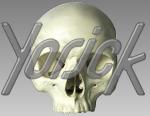
functions in plwf.i - p
|
plwf
|
plwf, z
or plwf, z, y,x
plots a 3-D wire frame of the given Z array, which must have the
same dimensions as the mesh (X, Y). If X and Y are not given, they
default to the first and second indices of Z, respectively.
The drawing order of the zones is determined by a simple "painter's
algorithm", which works fairly well if the mesh is reasonably near
rectilinear, but can fail even then if the viewpoint is chosen to
produce extreme fisheye perspective effects. Look at the resulting
plot carefully to be sure the algorithm has correctly rendered the
model in each case.
KEYWORDS: fill -- optional colors to use (default is to make zones
have background color), same dimension options as
for z argument to plf function
shade -- set non-zero to compute shading from current
3D lighting sources
edges -- default is 1 (draw edges), but if you provide fill
colors, you may set to 0 to supress the edges
ecolor, ewidth -- color and width of edges
cull -- default is 1 (cull back surfaces), but if you want
to see the "underside" of the model, set to 0
scale -- by default, Z is scaled to "reasonable" maximum
and minimum values related to the scale of (X,Y).
This keyword alters the default scaling factor, in
the sense that scale=2.0 will produce twice the
Z-relief of the default scale=1.0.
cmax -- the ambient= keyword in light3 can be used to
control how dark the darkest surface is; use this
to control how light the lightest surface is
the lightwf routine can change this parameter
interactively
interpreted function, defined at i/plwf.i line 13
| |
| SEE ALSO: |
lightwf,
plm,
plf,
orient3,
light3,
window3,
limit3 |
|